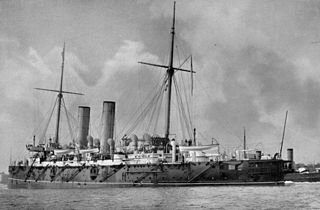
HMS Gibraltar, was an Edgar-class cruiser launched in 1892 for service in the Royal Navy. She was built and engineered by Messrs Napier of Glasgow. Of 7,700 loaded displacement, she was coal-fired with four double-ended cylindrical boilers driving two shafts. She could make 20 knots (37 km/h) with forced draught and 18 knots (33 km/h) with natural draught. She was a very good sea boat and an exceptional steamer.
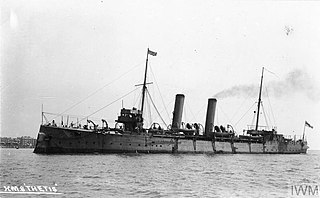
HMS Thetis was an Apollo-class second-class protected cruiser of the Royal Navy, launched on 13 December 1890. Her first significant mission was service in the Bering Sea Patrol with American warships in a combined effort to suppress poaching in the Bering Sea.

HMS Fox was a second class protected cruiser of the Astraea class of the Royal Navy. The class represented an improvement on previous types, 1,000 tons displacement larger with better seaworthiness due to improved hull design. It also had somewhat increased firepower and superior arrangement of guns.

The Anglo-Zanzibar War was a military conflict fought between the United Kingdom and the Sultanate of Zanzibar on 27 August 1896. The conflict lasted between 38 and 45 minutes, marking it as the shortest recorded war in history. The immediate cause of the war was the suspicious death of the pro-British Sultan Hamad bin Thuwaini on 25 August 1896 and the subsequent succession of Sultan Khalid bin Barghash. The British authorities preferred Hamoud bin Mohammed, who was more favourable to British interests, as sultan. The agreement of 14 June 1890, instituting a British protectorate over Zanzibar, specified that a candidate for accession to the sultanate should obtain the permission of the British consul; Khalid had not fulfilled this requirement. The British considered this a casus belli and sent an ultimatum to Khalid demanding that he order his forces to stand down and leave the palace. In response, Khalid called up his palace guard and barricaded himself inside the palace.

HMS Hawke, launched in 1891 from Chatham Dockyard, was the seventh Royal Navy warship to be named Hawke. She was an Edgar-class protected cruiser.

HMS Pegasus was one of 11 Pelorus-class protected cruisers ordered for the Royal Navy in 1893 under the Spencer Program and based on the earlier Pearl class. The class were fitted with a variety of different boilers, most of which were not entirely satisfactory, and by 1914, four ships had been withdrawn. They had all been condemned in 1904 but were reprieved and remained in service, with scrapping proposed in 1915.

HMS Grafton was a first class cruiser of the Edgar class, launched in 1892. She served in colonial service and in the First World War. Grafton survived the war and was broken up in the 1920s.
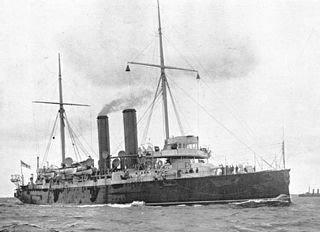
HMS St George was a first class cruiser of the Edgar class. She was launched on 23 June 1892.
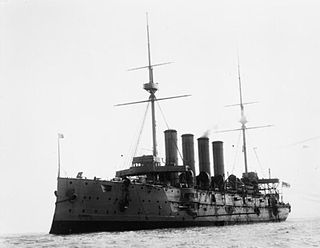
HMS Diadem was the lead ship of the Diadem-class of protected cruiser in the Royal Navy.

HMS Amphitrite was a ship of the Diadem-class of protected cruisers in the Royal Navy, which served in the First World War.

HMS Talbot was an Eclipse-class protected cruiser built for the Royal Navy in the mid-1890s.

HMS Sparrow was a Redbreast-class gunboat launched in 1889, the sixth Royal Navy ship to bear the name. She became the New Zealand training ship NZS Amokura in 1906 and was sold in 1922.

HMS Flora was an Astraea-class cruiser of the Royal Navy launched on 21 November 1893. She was constructed under the Naval Defence Act 1889 along with several other Astraea-class cruisers. Flora was decommissioned in 1922.

HMS Thrush was a Redbreast-class composite gunboat, the third ship of the name to serve in the Royal Navy.

HMS Astraea was an Astraea-class second class cruiser of the Royal Navy. She was built towards the end of the nineteenth century, and survived to serve in the First World War.
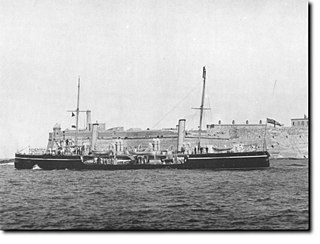
The sixth HMS Harrier was a Dryad-class torpedo gunboat. She was launched at Devonport Dockyard on 20 February 1894, and saw service in the Mediterranean and in fishery protection. She served as a minesweeper during World War I and was sold for commercial use in 1920.

HMS Icarus was a Mariner-class composite screw gunvessel of 8 guns, and the third Royal Navy vessel to carry the name. She was launched in 1885 at Devonport and sold in 1904.

HMS Pandora was a Pelorus-class cruiser of the Royal Navy. There were eleven "Third class" protected cruisers in the class, which was designed by Sir William White. While well armed for their size, they were primarily workhorses for the overseas fleet on "police" duties and did not serve with the main battlefleet.
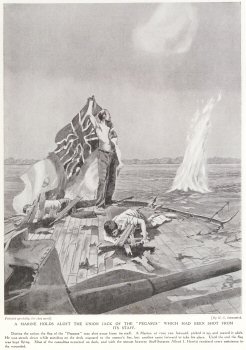
The Battle of Zanzibar was an encounter between the German Kaiserliche Marine and the British Royal Navy early in the First World War. While taking on coal in the delta of the Rufiji River in German East Africa, the German cruiser SMS Königsberg learned that a British cruiser, HMS Pegasus, which had been part of the Royal Navy's Cape Squadron sent to counter Königsberg, had put in at Zanzibar for repairs. Königsberg's captain, Commander Max Looff, decided to attack Pegasus while she was in port.
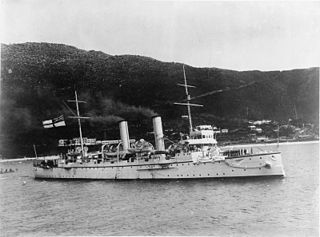
HMS Forte was an Astraea-class cruiser of the Royal Navy launched on 9 December 1893. She was constructed under the Naval Defence Act of 1889 along with several other Astraea-class cruisers. Forte was eventually decommissioned in 1913.






















